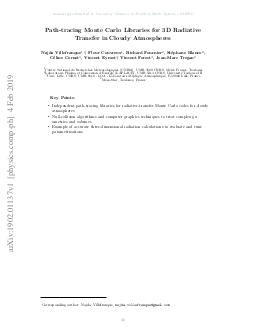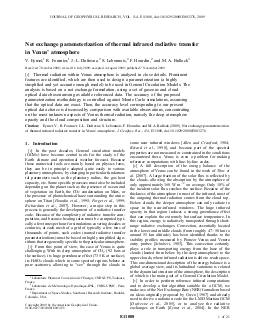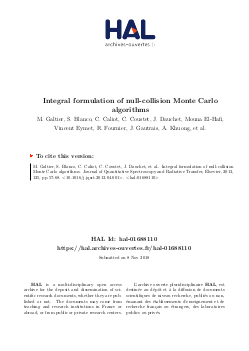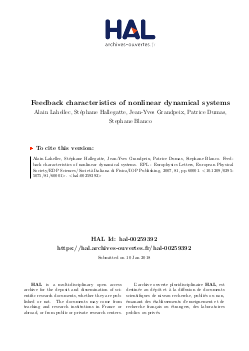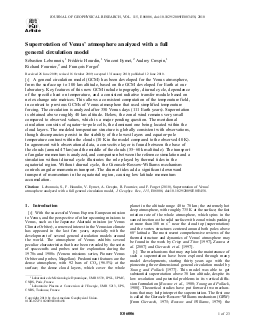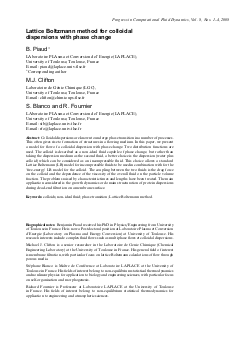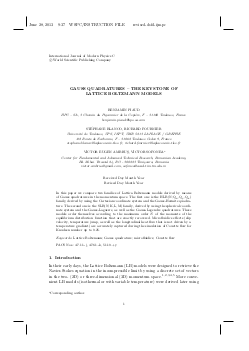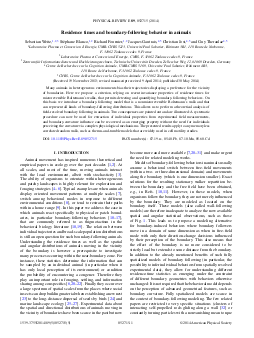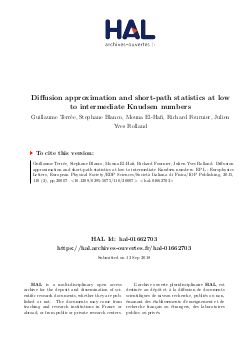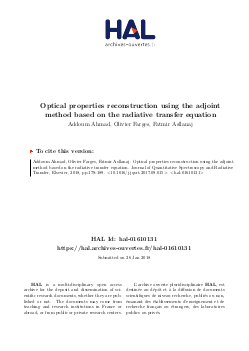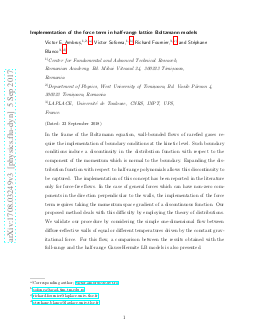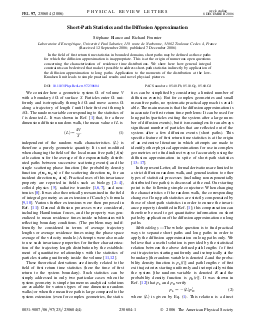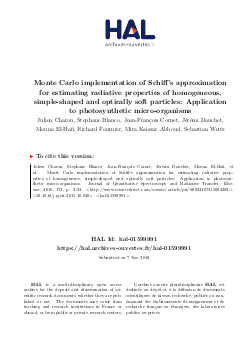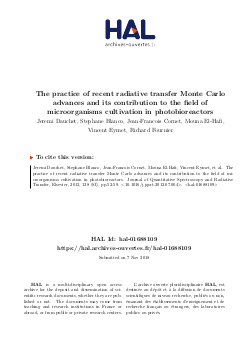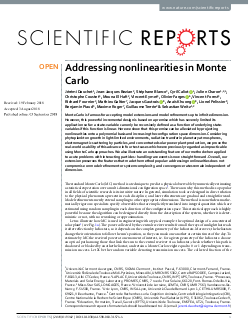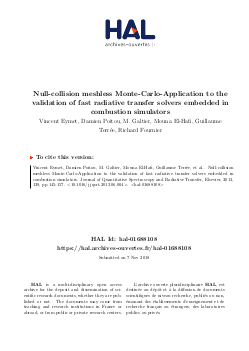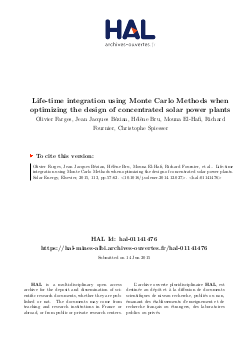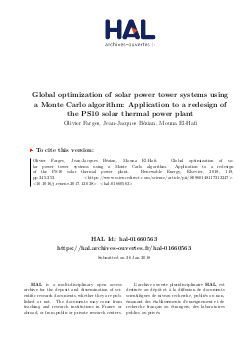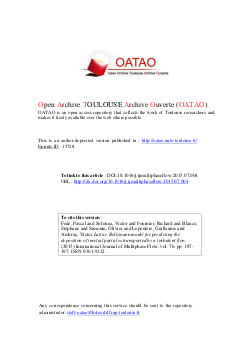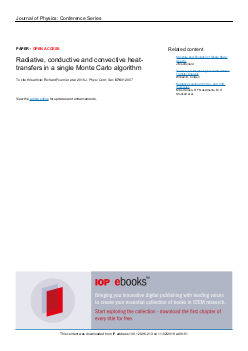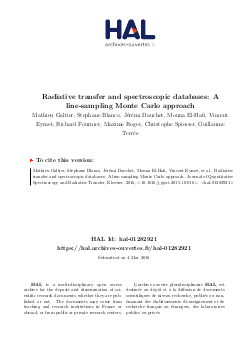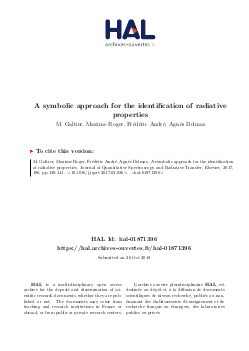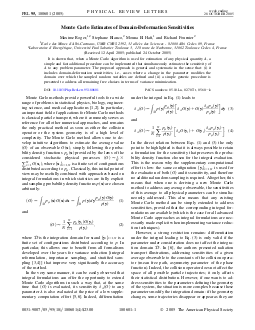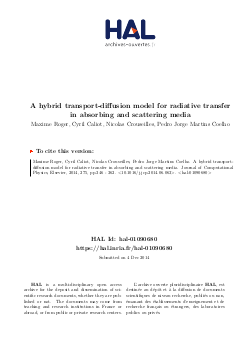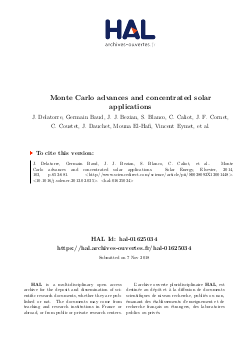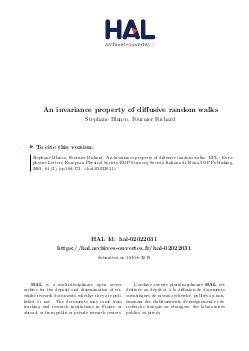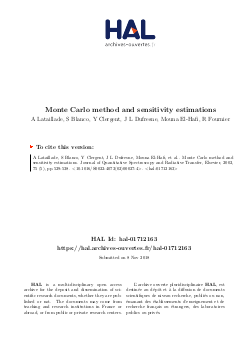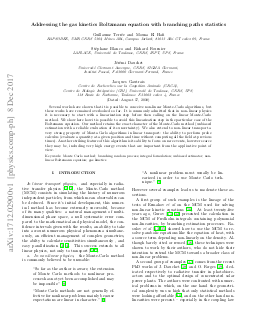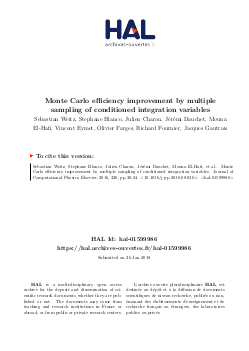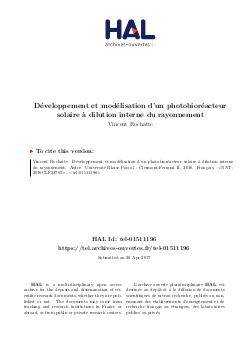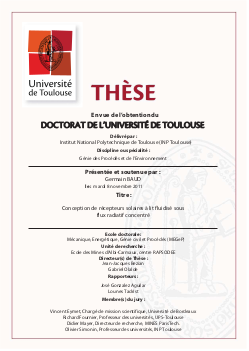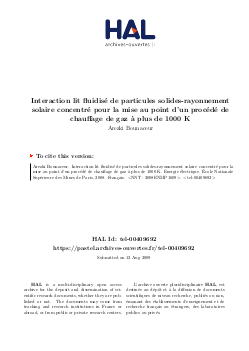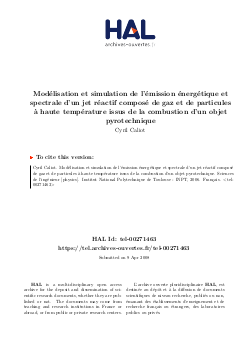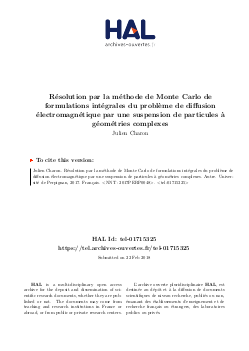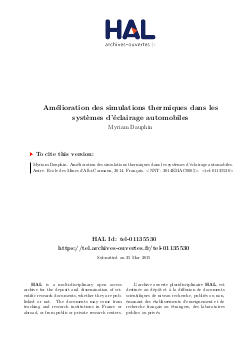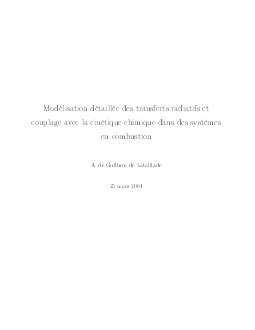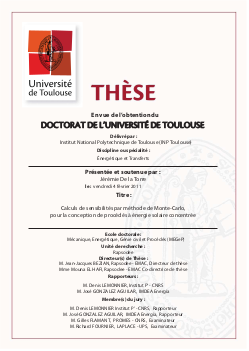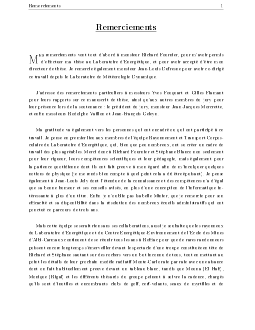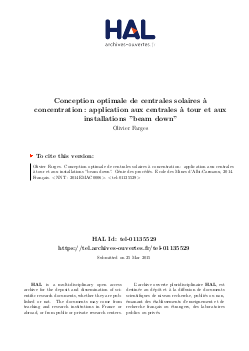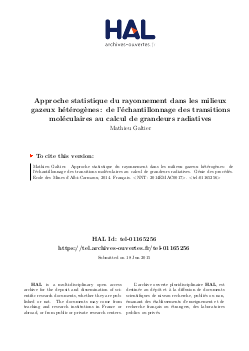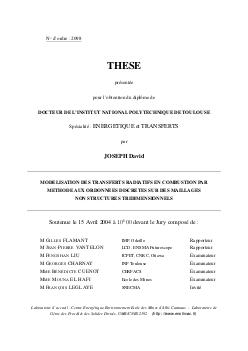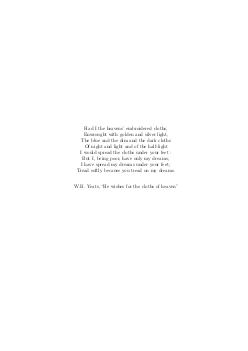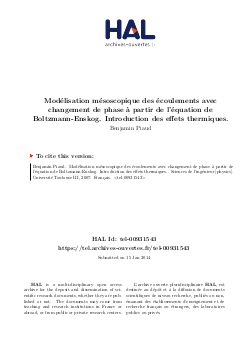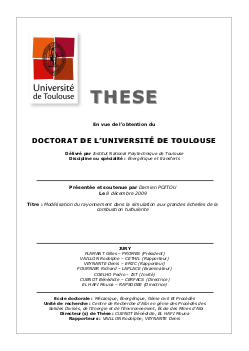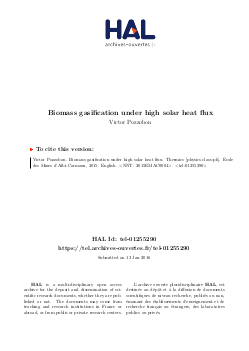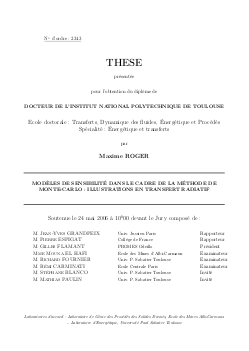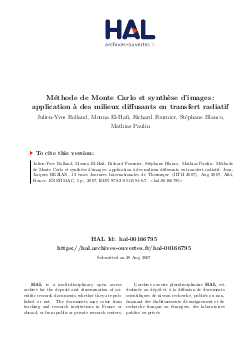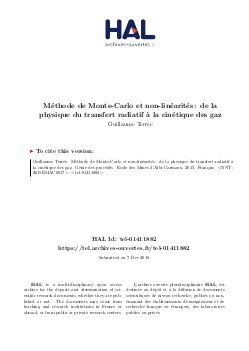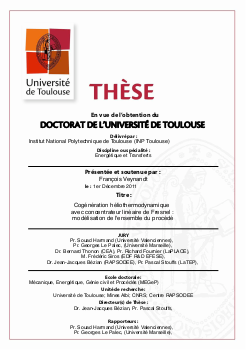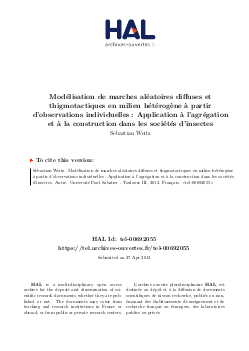Articles
. arXiv:1902.01137.
Path-tracing Monte Carlo Libraries for 3D Radiative Transfer in Cloudy Atmospheres.
arXiv e-prints
.
(arXiv:1902.01137)
, page(s) arXiv:1902.01137
.
Mots clés :
Physics - Computational Physics
Résumé :
Interactions between clouds and radiation are at the root of many difficulties in numerically predicting future weather and climate and in retrieving the state of the atmosphere from remote sensing observations. The large range of issues related to these interactions, and in particular to three-dimensional interactions, motivated the development of accurate radiative tools able to compute all types of radiative metrics, from monochromatic, local and directional observables, to integrated energetic quantities. In the continuity of this community effort, we propose here open-source radiative tools based on Monte Carlo algorithms. These tools are designed and distributed as a set of modular, independent libraries allowing the rapid design of specific codes for each new applicative requirement. Besides the implementation of state-of-the-art data access, parallelization and ray-casting acceleration techniques, we make use of integral formulations and null-collision algorithms to handle complex heterogeneous cloudy fields. Three example algorithms are described to illustrate the diversity of questions that can be addressed with these tools: rendering of synthetic images, analysis of transmission under a cloud and its sensitivity to an optical parameter, and assessment of a parametrization of 3D radiative effects of clouds. We apply them in realistic shallow cumulus fields output from Large Eddy Simulations.
. 2015.
Calculation of the radiative properties of photosynthetic microorganisms.
Journal of Quantitative Spectroscopy and Radiative Transfer
.
161
(2015)
, page(s) 60 - 84
.
Mots clés :
Photobioreactor
Résumé :
Abstract A generic methodological chain for the predictive calculation of the light-scattering and absorption properties of photosynthetic microorganisms within the visible spectrum is presented here. This methodology has been developed in order to provide the radiative properties needed for the analysis of radiative transfer within photobioreactor processes, with a view to enable their optimization for large-scale sustainable production of chemicals for energy and chemistry. It gathers an electromagnetic model of light-particle interaction along with detailed and validated protocols for the determination of input parameters: morphological and structural characteristics of the studied microorganisms as well as their photosynthetic-pigment content. The microorganisms are described as homogeneous equivalent-particles whose shape and size distribution is characterized by image analysis. The imaginary part of their refractive index is obtained thanks to a new and quite extended database of the in vivo absorption spectra of photosynthetic pigments (that is made available to the reader). The real part of the refractive index is then calculated by using the singly subtractive Kramers-Kronig approximation, for which the anchor point is determined with the Bruggeman mixing rule, based on the volume fraction of the microorganism internal-structures and their refractive indices (extracted from a database). Afterwards, the radiative properties are estimated using the Schiff approximation for spheroidal or cylindrical particles, as a first step toward the description of the complexity and diversity of the shapes encountered within the microbial world. Finally, these predictive results are confronted to experimental normal-hemispherical transmittance spectra for validation. This entire procedure is implemented for Rhodospirillum rubrum, Arthrospira platensis and Chlamydomonas reinhardtii, each representative of the main three kinds of photosynthetic microorganisms, i.e. respectively photosynthetic bacteria, cyanobacteria and eukaryotic microalgae. The obtained results are in very good agreement with the experimental measurements when the shape of the microorganisms is well described (in comparison to the standard volume-equivalent sphere approximation). As a main perspective, the consideration of the helical shape of Arthrospira platensis appears to be a key to an accurate estimation of its radiative properties. On the whole, the presented methodological chain also appears of great interest for other scientific communities such as atmospheric science, oceanography, astrophysics and engineering.
. 2004.
Long-wave radiative analysis of cloudy scattering atmospheres using a net exchange formulation.
Atmospheric Research
.
72
(2004)
, page(s) 239--261
.
Mots clés :
clouds,net-exchange formulation,radiation,scattering,terrestrial gcm
Résumé :
The Net Exchange Formulation (NEF) is an alternative to the usual radiative transfer equation. It was proposed in 1967 by Green [Q. J. R. Meteorol. Soc. 93 (1967) 371] for atmospheric sciences and by Hottel [H.C. Hottel, A.F. Sarofim. Radiative Transfer McGraw Hill, New York, 1967] for engineering sciences. Until now, the NEF has been used only in a very few cases for atmospheric studies. Recently we have developed a long-wave radiative code based on this formulation for a GCM of the Mars planet. Here, we will present results for the Earth atmosphere, obtained with a Monte Carlo Method based on the NEF. In this method, fluxes are not addressed any more. The basic variables are the net exchange rates (NER) between each pair of atmospheric layer (i, j), i.e. the radiative power emitted by i and absorbed by j minus the radiative power emitted by j and absorbed by i. The graphical representation of the NER matrix highlights the radiative exchanges that dominate the radiative budget of the atmosphere and allows one to have a very good insight of the radiative exchanges. Results will be presented for clear sky atmospheres with Mid-Latitude Summer and Sub-Arctic Winter temperature profiles, and for the same atmospheres with three different types of clouds. The effect of scattering on long-wave radiative exchanges will also be analysed.
. 2005.
A boundary-based net-exchange Monte Carlo method for absorbing and scattering thick media.
Journal of Quantitative Spectroscopy and Radiative Transfer
.
91
(2005)
, page(s) 27--46
.
Mots clés :
convergence,monte carlo,net-exchange formulation,numerical optimization,scattering
Résumé :
A boundary-based net-exchange Monte Carlo method was introduced (JQSRT 74 (2001) 563) that allows to bypass the difficulties encountered by standard Monte Carlo algorithms in the limit of optically thick absorption (and/or for quasi-isothermal configurations). With the present paper, this method is extended to scattering media. Developments are fully 3D, but illustrations are presented for plane parallel configuration. Compared to standard Monte Carlo algorithms, convergence qualities have been improved over a wide range of absorption and scattering optical thicknesses. The proposed algorithm still encounters a convergence difficulty in the case of optically thick, highly scattering media.
. 2009.
Net exchange parameterization of thermal infrared radiative transfer in Venus' atmosphere.
Journal of Geophysical Research: Planets
.
114
(2009)
, page(s) E11008
.
Résumé :
Thermal radiation within Venus atmosphere is analyzed in close details. Prominent features are identified, which are then used to design a parameterization (a highly simplified and yet accurate enough model) to be used in General Circulation Models. The analysis is based on a net exchange formulation, using a set of gaseous and cloud optical data chosen among available referenced data. The accuracy of the proposed parameterization methodology is controlled against Monte Carlo simulations, assuming that the optical data are exact. Then, the accuracy level corresponding to our present optical data choice is discussed by comparison with available observations, concentrating on the most unknown aspects of Venus thermal radiation, namely the deep atmosphere opacity and the cloud composition and structure.
. 2013.
Integral formulation of null-collision Monte Carlo algorithms.
Journal of Quantitative Spectroscopy and Radiative Transfer
.
125
(2013)
, Elsevier.
Mots clés :
Heterogeneous media,Integral formulation,Monte Carlo,Null-collision
Résumé :
At the kinetic level, the meaning of null-collisions is straightforward: they correspond to pure-forward scattering events. We here discuss their technical significance in integral terms. We first consider a most standard null-collision Monte Carlo algorithm and show how it can be rigorously justified starting from a Fredholm equivalent to the radiative transfer equation. Doing so, we also prove that null-collision algorithms can be slightly modified so that they deal with unexpected occurrences of negative values of the null-collision coefficient (when the upper bound of the heterogeneous extinction coefficient is nonstrict). We then describe technically, in full details, the resulting algorithm, when applied to the evaluation of the local net-power density within a bounded, heterogeneous, multiple scattering and emitting/absorbing medium. The corresponding integral formulation is then explored theoretically in order to distinguish the statistical significance of introducing null-collisions from that of the integral-structure underlying modification.
. 2008.
Feedback characteristics of nonlinear dynamical systems.
Europhysics Letters
.
81
(2008)
.
Résumé :
We propose a method to extend the concept of feedback gain to nonlinear models. The method is designed to dynamically characterise a feedback mechanism along the system natural trajectory. The numerical efficiency of the method is proved using the Lorenz (1963) classical model. Finally, a simple climate model of water vapour feedback shows how nonlinearity impacts feedback intensity along the seasonal cycle.
. 2010.
Superrotation of Venus' atmosphere analyzed with a full general circulation model.
Journal of Geophysical Research: Planets
.
115
(2010)
, page(s) E06006
.
Résumé :
A general circulation model (GCM) has been developed for the Venus atmosphere, from the surface up to 100 km altitude, based on the GCM developed for Earth at our laboratory. Key features of this new GCM include topography, diurnal cycle, dependence of the specific heat on temperature, and a consistent radiative transfer module based on net exchange rate matrices. This allows a consistent computation of the temperature field, in contrast to previous GCMs of Venus atmosphere that used simplified temperature forcing. The circulation is analyzed after 350 Venus days (111 Earth years). Superrotation is obtained above roughly 40 km altitude. Below, the zonal wind remains very small compared to observed values, which is a major pending question. The meridional circulation consists of equator-to-pole cells, the dominant one being located within the cloud layers. The modeled temperature structure is globally consistent with observations, though discrepancies persist in the stability of the lowest layers and equator-pole temperature contrast within the clouds (10 K in the model compared to the observed 40 K). In agreement with observational data, a convective layer is found between the base of the clouds (around 47 km) and the middle of the clouds. The transport of angular momentum is analyzed, and comparison between the reference simulation and a simulation without diurnal cycle illustrates the role played by thermal tides in the equatorial region. Without diurnal cycle, the Gierasch-Rossow-Williams mechanism controls angular momentum transport. The diurnal tides add a significant downward transport of momentum in the equatorial region, causing low latitude momentum accumulation.
. 2008.
Lattice Boltzmann method for colloidal dispersions with phase change.
Progress in Computational Fluid Dynamics
.
8
(2008)
, page(s) 129--137
.
Résumé :
Colloidal dispersions are known to undergo phase transition in a number of processes. This often gives rise to formation of structures in a flowing medium. In this paper, we present a model for flow of a colloidal dispersion with phase change. Two distribution functions are used. The colloid is described as a non-ideal fluid capable of phase change, but rather than taking the dispersion medium as the second fluid, a better choice is the dispersion (water plus colloid) which can be considered as an incompressible fluid. This choice allows a standard Lattice Boltzmann (LB) model for incompressible fluids to be used in combination with for the 'free-energy' LB model for the colloid. The coupling between the two fluids is the drag force on the colloid and the dependence of the viscosity of the overall fluid on the particle volume fraction. The problems raised by characteristic times and lengths have been treated. The main application considered is the growth dynamics or domain structuration of protein dispersions during dead-end filtration on a membrane surface.
. 2014.
Gauss quadratures - The Keystone of Lattice Boltzmann Models.
International Journal of Modern Physics C
.
25
(2014)
, page(s) 1340016
.
Mots clés :
Lattice Boltzmann; Gauss quadrature; microfluidics; Couette flow
Résumé :
In this paper, we compare two families of Lattice Boltzmann (LB) models derived by means ofGauss quadratures in the momentum space. The first one is the HLB($N;Q_x,Q_y,Q_z$) family, derived by using the Cartesian coordinate system and the Gauss-Hermite quadrature. Thesecond one is the SLB($N;K,L,M$) family, derived by using the spherical coordinate system and the Gauss-Laguerre, as well as the Gauss-Legendre quadratures. These models order them- selves according to the maximum order N of the moments of the equilibrium distribution function that are exactly recovered. Microfluidics effects (slip velocity, temperature jump, as well as the longitudinal heat fluux that is not driven by a temperature gradient) are accurately captured during the simulation of Couette flow for Knudsen number (kn) up to 0.25.
. 2017.
Radiative transfer approach using Monte Carlo Method for actinometry in complex geometry and its application to Reinecke salt photodissociation within innovative pilot-scale photo(bio)reactors.
Chemical Engineering Journal
.
308
(2017)
, page(s) 940 - 953
.
Mots clés :
Actinometry, Radiative transfer, Monte Carlo Method, Complex geometry, Photon absorption probability
Résumé :
In this article, a complete radiative transfer approach for estimating incident photon flux density by actinometry is presented that opens the door to investigation of large-scale intensified photoreactors. The approach is based on an original concept: the analysis of the probability that a photon entering the reaction volume is absorbed by the actinometer. Whereas this probability is assumed to be equal to one in classical actinometry, this assumption can no longer be satisfied in many practical situations in which optical thicknesses are low. Here we remove this restriction by using most recent advances in the field of radiative transfer Monte Carlo, in order to rigorously evaluate the instantaneous absorption-probability as a function of conversion. Implementation is performed in EDStar, an open-source development environment that enables straightforward simulation of reactors with any geometry (directly provided by their CAD-file), with the very same Monte Carlo algorithm. Experimental investigations are focused on Reinecke salt photodissociation in two reactors designed for the study of natural and artificial photosynthesis. The first reactor investigated serves as reference configuration: its simple torus geometry allows to compare flux densities measured with quantum sensors and actinometry. Validations and analysis are carried out on this reactor. Then, the approach is implemented on a 25L photobioreactor with complex geometry corresponding to one thousand light-diffusing optical fibers distributing incident photons within the reaction volume. Results show that classical actinometry neglecting radiative transfer can lead to 50 percent error when measuring incident flux density for such reactors. Finally, we show how this radiative transfer approach paves the way for analyzing high conversion as a mean to investigate angular distribution of incident photons.
. 2014.
Residence times and boundary-following behavior in animals.
Physical Review E
.
89
(2014)
, page(s) 052715
.
Résumé :
Many animals in heterogeneous environments bias their trajectories displaying a preference for the vicinity of boundaries. Here we propose a criterion, relying on recent invariance properties of residence times for microreversible Boltzmann's walks, that permits detecting and quantifying boundary-following behaviors. On this basis we introduce a boundary-following model that is a nonmicroreversible Boltzmann's walk and that can represent all kinds of boundary-following distributions. This allows us to perform a theoretical analysis of field-resolved boundary following in animals. Two consequences are pointed out and are illustrated: A systematic procedure can now be used for extraction of individual properties from experimental field measurements, and boundary-curvature influence can be recovered as an emerging property without the need for individuals perceiving the curvature via complex physiological mechanisms. The presented results apply to any memoryless correlated random walk, such as the run-and-tumble models that are widely used in cell motility studies.
. 2015.
Diffusion approximation and short-path statistics at low to intermediate Knudsen numbers.
EPL (Europhysics Letters)
.
110
(2015)
, page(s) 20007
.
Résumé :
In the field of first-return statistics in bounded domains, short paths may be defined as those paths for which the diffusion approximation is inappropriate. However, general integral constraints have been identified that make it possible to address such short-path statistics indirectly by application of the diffusion approximation to long paths in a simple associated first-passage problem. This approach is exact in the zero Knudsen limit ( Blanco S. and Fournier R., Phys. Rev. Lett. , 97 (2006) 230604). Its generalization to the low to intermediate Knudsen range is addressed here theoretically and the corresponding predictions are compared to both one-dimension analytical solutions and three-dimension numerical experiments. Direct quantitative relations to the solution of the Schwarzschild-Milne problem are identified.
. 2018.
Optical properties reconstruction using the adjoint method based on the radiative transfer equation.
Journal of Quantitative Spectroscopy and Radiative Transfer
.
204
(2018)
, page(s) 179--189
, Elsevier.
Résumé :
An efficient algorithm is proposed to reconstruct the spatial distribution of optical properties in heterogeneous media like biological tissues. The light transport through such media is accurately described by the radiative transfer equation in the frequency-domain. The adjoint method is used to efficiently compute the objective function gradient with respect to optical parameters. Numerical tests show that the algorithm is accurate and robust to retrieve simultaneously the absorption $\mu_a$ and scattering $\mu_s$ coefficients for lowly and highly absorbing medium. Moreover, the simultaneous reconstruction of $\mu_s$ and the anisotropy factor g of the Henyey-Greenstein phase function is achieved with a reasonable accuracy. The main novelty in this work is the reconstruction of g which might open the possibility to image this parameter in tissues as an additional contrast agent in optical tomography.
. 2017.
Implementation of the force term in half-range lattice Boltzmann models.
arXiv preprint arXiv:1708.03249
.
(2017)
.
Résumé :
In the frame of the Boltzmann equation, wall-bounded flows of rarefied gases require the implementation of boundary conditions at the kinetic level, such as diffuse reflection. Such boundary conditions induce a discontinuity in the distribution function with respect to the component of the momentum which is normal to the boundary. In this paper, we present the procedure for the implementation of the force term in lattice Boltzmann models based on half-range quadratures. We validate our construction by considering one-dimensional flows between diffuse-reflective boundaries of equal or different temperatures which are driven by a constant force. A comparison between the conventional full-range Hermite model and the half-range Gauss-Hermite model is also presented.
. 2006.
Short-path statistics and the diffusion approximation.
Physical Review Letters
.
97
(2006)
, page(s) 4
.
Mots clés :
RANDOM-WALKS; BOUNDED DOMAINS; BODIES
Résumé :
In the field of first return time statistics in bounded domains, short paths may be defined as those paths for which the diffusion approximation is inappropriate. This is at the origin of numerous open questions concerning the characterization of residence time distributions. We show here how general integral constraints can be derived that make it possible to address short-path statistics indirectly by application of the diffusion approximation to long paths. Application to the moments of the distribution at the low-Knudsen limit leads to simple practical results and novel physical pictures.
. 2015.
Validation of a Monte Carlo integral formulation applied to solar facility simulations and use of sensitivities.
Journal of Solar Energy Engineering
.
137
(2015)
, page(s) 021019
, American Society of Mechanical Engineers.
Résumé :
The design of solar concentrating systems and receivers requires the spatial distribution of the solar flux on the receiver. This article presents an integral formulation of the optical model which is solved by a Monte Carlo Ray-Tracing algorithm that handles complex geometries involved in solar concentrating facilities. An experimental validation of this model is obtained with published results for a Dish configuration. The convergence of the proposed algorithm is studied and found faster than collision-based algorithms. In addition, an example of the use of the sensitivity of the power on a target to the mirror rms-slope is given by treating an inverse problem consisting in finding the equivalent rms-slope of mirrors that best match the flux map measurements.
. 2016.
Monte Carlo implementation of Schiff's approximation for estimating radiative properties of homogeneous, simple-shaped and optically soft particles: Application to photosynthetic micro-organisms.
Journal of Quantitative Spectroscopy and Radiative Transfer
.
172
(2016)
, page(s) 3--23
, Elsevier.
Résumé :
In the present paper, Schiff's approximation is applied to the study of light scattering by large and optically-soft axisymmetric particles, with special attention to cylindrical and spheroidal photosynthetic micro-organisms. This approximation is similar to the anomalous diffraction approximation but includes a description of phase functions. Resulting formulations for the radiative properties are multidimensional integrals, the numerical resolution of which requires close attention. It is here argued that strong benefits can be expected from a statistical resolution by the Monte Carlo method. But designing such efficient Monte Carlo algorithms requires the development of non-standard algorithmic tricks using careful mathematical analysis of the integral formulations: the codes that we develop (and make available) include an original treatment of the nonlinearity in the differential scattering cross-section (squared modulus of the scattering amplitude) thanks to a double sampling procedure. This approach makes it possible to take advantage of recent methodological advances in the field of Monte Carlo methods, illustrated here by the estimation of sensitivities to parameters. Comparison with reference solutions provided by the T-Matrix method is presented whenever possible. Required geometric calculations are closely similar to those used in standard Monte Carlo codes for geometric optics by the computer-graphics community, i.e. calculation of intersections between rays and surfaces, which opens interesting perspectives for the treatment of particles with complex shapes.
. 2013.
The practice of recent radiative transfer Monte Carlo advances and its contribution to the field of microorganisms cultivation in photobioreactors.
Journal of Quantitative Spectroscopy and Radiative Transfer
.
128
(2013)
, page(s) 52--59
, Elsevier.
Résumé :
The present text illustrates the practice of integral formulation, zero-variance approaches and sensitivity evaluations in the field of radiative transfer Monte Carlo simulation, as well as the practical implementation of the corresponding algorithms, for such realistic systems as photobioreactors involving spectral integration, multiple scattering and complex geometries. We try to argue that even in such non-academic contexts, strong benefits can be expected from the effort of translating the considered Monte Carlo algorithm into a rigorously equivalent integral formulation. Modifying the initial algorithm to simultaneously compute sensitivities is then straightforward (except for domain deformation sensitivities) and the question of enhancing convergence is turned into that of modeling a set of well identified physical quantities.
. 2018.
Addressing nonlinearities in Monte Carlo.
Scientific reports
.
8
(2018)
, page(s) 13302
, Nature Publishing Group.
Résumé :
Monte Carlo is famous for accepting model extensions and model refinements up to infinite dimension. However, this powerful incremental design is based on a premise which has severely limited its application so far: a state-variable can only be recursively defined as a function of underlying state-variables if this function is linear. Here we show that this premise can be alleviated by projecting nonlinearities onto a polynomial basis and increasing the configuration space dimension. Considering phytoplankton growth in light-limited environments, radiative transfer in planetary atmospheres, electromagnetic scattering by particles, and concentrated solar power plant production, we prove the real-world usability of this advance in four test cases which were previously regarded as impracticable using Monte Carlo approaches. We also illustrate an outstanding feature of our method when applied to acute problems with interacting particles: handling rare events is now straightforward. Overall, our extension preserves the features that made the method popular: addressing nonlinearities does not compromise on model refinement or system complexity, and convergence rates remain independent of dimension.
. 2013.
Null-collision meshless Monte-Carlo-Application to the validation of fast radiative transfer solvers embedded in combustion simulators.
Journal of Quantitative Spectroscopy and Radiative Transfer
.
129
(2013)
, page(s) 145--157
, Elsevier.
Résumé :
The Monte-Carlo method is often presented as a reference method for radiative transfer simulation when dealing with participating, inhomogeneous media. The reason is that numerical uncertainties are only of a statistical nature and are accurately evaluated by measuring the standard deviation of the Monte Carlo weight. But classical Monte-Carlo algorithms first sample optical thicknesses and then determine absorption or scattering locations by inverting the formal integral definition of optical thickness as an increasing function of path length. This function is only seldom analytically invertible and numerical inversion procedures are required. Most commonly, a volumic grid is introduced and optical properties within each cell are replaced by approximate homogeneous or linear fields. Simulation results are then sensitive to the grid and can no longer be considered as references. We propose a new algorithmic formulation based on the use of null-collisions that eliminate the need for numerical inversion: no volumic grid is required. Benchmark configurations are first considered in order to evaluate the effect of two free parameters: the amount of null-collisions, and the criterion used to decide at which stage a Russian Roulette is used to exit the path tracking process. Then the corresponding algorithm is implemented using a development environment allowing to deal with complex geometries (thanks to computer graphics techniques), leading to a Monte Carlo code that can be easily used for validation of fast radiative transfer solvers embedded in combustion simulators. "Easily" means here that the way the Monte Carlo algorithm deals with both the geometry and the temperature/pressure/concentration fields is independent of the choices made inside the combustion solver: there is no need for the design of a new path-tracking procedure adapted to each new CFD grid. The Monte Carlo simulator is ready for use as soon as combustion specialists provide a localization/interpolation tool defining what they consider as the continuous input fields best suiting their numerical assumptions. The radiation validation tool introduces no grid in itself.
. 2015.
Life-time integration using Monte Carlo Methods when optimizing the design of concentrated solar power plants.
Solar Energy
.
113
(2015)
, page(s) 57--62
, Elsevier.
Résumé :
Rapidity and accuracy of algorithms evaluating yearly collected energy are an important issue in the context of optimizing concentrated solar power plants (CSP). These last ten years, several research groups have concentrated their efforts on the development of such sophisticated tools: approximations are required to decrease the CPU time, closely checking that the corresponding loss in accuracy remains acceptable. Here we present an alternative approach using the Monte Carlo Methods (MCM). The approximation effort is replaced by an integral formulation work leading to an algorithm providing the exact yearly-integrated solution, with computation requirements similar to that of a single date simulation. The corresponding theoretical framework is fully presented and is then applied to the simulation of PS10.
. 2018.
Global optimization of solar power tower systems using a Monte Carlo algorithm: Application to a redesign of the PS10 solar thermal power plant.
Renewable Energy
.
119
(2018)
, page(s) 345--353
, Elsevier.
Résumé :
There is a need to enhance the performance of Solar Power Tower (SPT) systems in view of their significant capital costs. In this context, the preliminary design step is of great interest as improvements here can reduce the global cost. This paper presents an optimization method that approaches optimal SPT system design through the coupling of a Particle Swarm Optimization algorithm and a Monte Carlo algorithm, in order to assess both the yearly heliostat field optical efficiency and the thermal energy collected annually by an SPT system. This global optimization approach is then validated on a well-known SPT system, ie the PS10 Solar Thermal Power plant. First, the direct model is compared to in-situ measurements and simulation results. Then, the PS10 heliostat field is redesigned using the optimization tool. This redesign step leads to an annual gain between 3.34\% and 23.5\% in terms of the thermal energy collected and up to about 9\% in terms of the heliostat field optical efficiency from case to case.
. 2015.
Lattice Boltzmann model for predicting the deposition of inertial particles transported by a turbulent flow.
International Journal of Multiphase Flow
.
76
(2015)
, page(s) 187--197
, Elsevier.
Résumé :
Deposition of inertial solid particles transported by turbulent flows is modelled in a framework of a statistical approach based on the particle velocity Probability Density Function (PDF). The particle-turbulence interaction term is closed in the kinetic equation by a model widely inspired from the famous BGK model of the kinetic theory of rarefied gases. A Gauss-Hermite Lattice Boltzmann model is used to solve the closed kinetic equation involving the turbulence effect. The Lattice Boltzmann model is used for the case of the deposition of inertial particles transported by a homogeneous isotropic turbulent flows. Even if the carrier phase is homogeneous and isotropic, the presence of the wall coupled with particle-turbulence interactions leads to inhomogeneous particle distribution and non-equilibrium particle fluctuating motion. Despite these complexities the predictions of the Lattice Boltzmann model are in very good accordance with random-walk simulations. More specifically the mean particle velocity, the r.m.s. particle velocity and the deposition rate are all well predicted by the proposed Lattice Boltzmann model.
. 2015.
Radiative, conductive and convective heat-transfers in a single Monte Carlo algorithm.
Journal of Physics: Conference Series
.
676
(2015)
, page(s) 012007
.
Résumé :
It was recently shown that null-collision algorithms could lead to grid-free radiative- transfer Monte Carlo algorithms that immediately benefit of computer-graphics tools for an efficient handling of complex geometries [1, 2]. We here explore the idea of extending the approach to heat transfer problems combining radiation, conduction and convection. This is possible as soon as the model can be given the form of a second-kind Fredholm equation. In the following pages, we show that this is quite straightforward at the stationnary limit in the linear case. The oral presentation will provide corresponding simulation examples. Perspectives will then be drawn concerning the extension to non-stationnary cases and non-linear coupling.
. 2016.
Radiative transfer and spectroscopic databases: A line-sampling Monte Carlo approach.
Journal of Quantitative Spectroscopy and Radiative Transfer
.
172
(2016)
, page(s) 83--97
, Elsevier.
Résumé :
Dealing with molecular-state transitions for radiative transfer purposes involves two successive steps that both reach the complexity level at which physicists start thinking about statistical approaches: (1) constructing line-shaped absorption spectra as the result of very numerous state-transitions, (2) integrating over optical-path domains. For the first time, we show here how these steps can be addressed simultaneously using the null-collision concept. This opens the door to the design of Monte Carlo codes directly estimating radiative transfer observables from spectroscopic databases. The intermediate step of producing accurate high-resolution absorption spectra is no longer required. A Monte Carlo algorithm is proposed and applied to six one-dimensional test cases. It allows the computation of spectrally integrated intensities (over 25cm-1 bands or the full IR range) in a few seconds, regardless of the retained database and line model. But free parameters need to be selected and they impact the convergence. A first possible selection is provided in full detail. We observe that this selection is highly satisfactory for quite distinct atmospheric and combustion configurations, but a more systematic exploration is still in progress.
. 2017.
A symbolic approach for the identification of radiative properties.
Journal of Quantitative Spectroscopy and Radiative Transfer
.
196
(2017)
, page(s) 130--141
, Elsevier.
Résumé :
A new Symbolic Monte Carlo (SMC) based on null-collision algorithms, allows 1/ overcoming the usually required knowledge of the optical thickness in SMC, and 2/ expressing radiative quantities as simple polynomials of the absorption and scattering coefficients. The proposed method can be applied to complex systems such as heterogeneous absorbing and scattering media in complex geometry. It opens new outlooks for the analysis and the identification of radiative properties in a wide range of radiative transfer applications in participating media.
. 2005.
Energy-conserving lattice Boltzmann thermal model in two dimensions.
Journal of Statistical Physics
.
121
(2005)
, page(s) 119-131
.
Mots clés :
thermal lattice Boltzmann; compressibility; BGK approximation; Gauss-Hermitte quadrature EQUATION; FLOWS
Résumé :
A discrete velocity model is presented for lattice Boltzmann thermal fluid dynamics. This model is implemented and tested in two dimensions with a finite difference scheme. Comparison with analytical solutions shows an excellent agreement even for wide temperature differences. An alternative approximate approach is then presented for traditional lattice transport schemes.
. 2005.
Monte Carlo estimates of domain-deformation sensitivities.
Physical review letters
.
95
(2005)
, page(s) 180601
, APS.
Résumé :
It is shown that, when a Monte Carlo algorithm is used for estimation of any physical quantity A, a simple and fast additional procedure can be implemented that simultaneously estimates the sensitivity of A to any problem parameter. The proposed approach is general and systematic in the sense that: (i) it includes domain-deformation sensitivities, i.e., cases where a change in the parameter modifies the domain over which the sampled random variables are defined and (ii) a simple generic procedure is presented to address all remaining free choices in terms of variance minimization.
. 2014.
A hybrid transport-diffusion model for radiative transfer in absorbing and scattering media.
Journal of Computational Physics
.
275
(2014)
, page(s) 346--362
, Elsevier.
Résumé :
A new multi-scale hybrid transport-diffusion model for radiative transfer is proposed in order to improve the efficiency of the calculations close to the diffusive regime, in absorbing and strongly scattering media. In this model, the radiative intensity is decomposed into a macroscopic component calculated by the diffusion equation, and a mesoscopic component. The transport equation for the mesoscopic component allows to correct the estimation of the diffusion equation, and then to obtain the solution of the linear radiative transfer equation. In this work, results are presented for stationary and transient radiative transfer cases, in examples which concern solar concentrated and optical tomography applications. The Monte Carlo and the discrete-ordinate methods are used to solve the mesoscopic equation. It is shown that the multi-scale model allows to improve the efficiency of the calculations when the medium is close to the diffusive regime. The proposed model is a good alternative for radiative transfer at the intermediate regime where the macroscopic diffusion equation is not accurate enough and the radiative transfer equation requires too much computational effort.
. 2014.
Monte Carlo advances and concentrated solar applications.
Solar Energy
.
103
(2014)
, page(s) 653-681
.
Résumé :
The Monte Carlo method is partially reviewed with the objective of illustrating how some of the most recent methodological advances can benefit to concentrated solar research. This review puts forward the practical consequences of writing down and handling the integral formulation associated to each Monte Carlo algorithm. Starting with simple examples and up to the most complex multiple reflection, multiple scattering configurations, we try to argue that these formulations are very much accessible to the non specialist and that they allow a straightforward entry to sensitivity computations (for assistance in design optimization processes) and to convergence enhancement techniques involving subtle concepts such as control variate and zero variance. All illustration examples mak use of the public domain development environment EDStar (including advanced parallelized computer graphics libraries) and are meant to serve as start basis either for the upgrading of existing Monte Carlo codes, or for fast implementation of ad hoc codes when specific needs cannot be answered with standard concentrated solar codes (in particular as far as the new generation of solar receivers is concerned). (C) 2013 Elsevier Ltd. All rights reserved.
. 2003.
An invariance property of diffusive random walks.
Europhysics Letters
.
61
(2003)
, page(s) 168-173
.
Mots clés :
PHOTON MIGRATION; PATH-INTEGRALS; APPROXIMATION; SCATTERING; MEDIA
Résumé :
Starting from a simple animal-biology example, a general, somewhat counter-intuitive property of diffusion random walks is presented. It is shown that for any (nonhomogeneous) purely diffusing system, under any isotropic uniform incidence, the average length of trajectories through the system ( the average length of the random walk trajectories from entry point to first exit point) is independent of the characteristics of the diffusion process and therefore depends only on the geometry of the system. This exact invariance property may be seen as a generalization to diffusion of the well-known mean-chord-length property (Case K.M. and Zweifel P.F., Linear Transport Theory (Addison-Wesley) 1967), leading to broad physics and biology applications.
. 2002.
Monte Carlo method and sensitivity estimations.
Journal of Quantitative Spectroscopy \& Radiative Transfer
.
75
(2002)
, page(s) 529-538
.
Mots clés :
Monte Carlo; sensitivity analysis NET-EXCHANGE FORMULATION; MODEL
Résumé :
It is shown that, starting from any existing Monte Carlo algorithm for estimation of a physical quantity A, it is possible to implement a simple additional procedure that simultaneously estimates the sensitivity of A to any problem parameter. The corresponding supplementary cost is very low as no additional random sampling is required. The principle is presented on a formal basis and simple radiative transfer examples are used for illustration. (C) 2002 Elsevier Science Ltd. All rights reserved.
. 2017.
Addressing the gas kinetics Boltzmann equation with branching paths statistics.
arXiv preprint arXiv:1712.02900
.
(2017)
.
Résumé :
Several works have shown that it is possible to conceive non-linear Monte-Carlo algorithms, but these works have remained overlooked so far. It is commonly admitted that in non-linear physics it is necessary to start with a linearization step before then calling on the linear Monte-Carlo method. We show here how it is possible to avoid this linearization step in the particular case of the Boltzmann equation. Our method retains the exact character of the Monte-Carlo method (unbiased estimation with a reliable evaluation of its uncertainty). We also extend to non-linear transport a very strong property of Monte-Carlo algorithms in linear transport: the ability to perform probe calculus (evaluate a quantity at a given position and time without computing all the field at previous times). Another striking feature of this algorithm is its ability to focus on rare events, however scarce they may be, including very high energy events that are important from the applicative point of view.
. 2016.
Monte Carlo efficiency improvement by multiple sampling of conditioned integration variables.
Journal of Computational Physics
.
326
(2016)
, page(s) 30--34
, Elsevier.
Résumé :
We present a technique that permits to increase the efficiency of multidimensional Monte Carlo algorithms when the sampling of the first, unconditioned random variable consumes much more computational time than the sampling of the remaining, conditioned random variables while its variability contributes only little to the total variance. This is in particular relevant for transport problems in complex and randomly distributed geometries. The proposed technique is based on an new Monte Carlo estimator in which the conditioned random variables are sampled more often than the unconditioned one. A significant contribution of the present Short Note is an automatic procedure for calculating the optimal number of samples of the conditioned random variable per sample of the unconditioned one. The technique is illustrated by a current research example where it permits to increase the efficiency by a factor 100.
Conférences
. 2003.
Etude de l'effet de serre sur les taux de chauffage atmosphérique infrarouges par une analyse en Puissances Nettes Echangées à l'aide d'une méthode de Monte-Carlo..
Les Ateliers de modélisation de l'atmosphère, Toulouse.
. 2003.
A Monte Carlo Method for radiative transfer parametrization in terrestrial GCM..
Eurotherm, Mons.
. 2003.
Longwave radiative exchange analysis of cloudy atmospheres with a net exchange formulation.
EGS-AGU-EUG, joint Assembly, Nice.
. 2018.
Rayonnement 3D SW et LW dans les nuages de couche limite : Monte Carlo et calcul de sensibilité.
Journées Ateliers de Modélisation de l'Atmosphère.
. 2018.
Combined conductive-radiative heat transfer analysis in complex geometry using the Monte Carlo method.
Eurotherm Seminar 110 – Computational Thermal Radiation in Participating Media - VIApril 11-13, Cascais, Portugal.
. 2015.
Approximation de Schiff appliquée au calcul de propriétés radiatives de micro-organismes photosynthétiques et résolution par la méthode de Monte Carlo..
JERT2015 - Journées d'Etudes en Rayonnement Thermique, 26-27 Novembre, ISAE-ENSMA, Poitiers, France.
. 2017.
A first investigation on solving integral equations of electromagnetic scattering with the Monte carlo method: application to arbitrary shaped particles.
16th Electromagnetic Light Scattering conference, Washington DC.
. 2017.
Combined conductive-radiative heat transfer analysis in complex geometry using the Monte Carlo method.
30th International Conference on Efficiency, Cost, Optimisation, Simulation and Environmental Impact of Energy Systems (ECOS2017) - San Diego, California - July 2. -6.
. 2017.
Résolution des transferts conducto-radiatifs par la méthode de Monte-Carlo en milieux poreux.
25eme Congrès Français de Thermique - Marseille - 30 Mai/ 2 Juin.
. 2010.
Transferts radiatifs dans les photobioreacteurs a eclairage interne..
Journees Rayonnement thermique en milieu semi-transparent du groupe Modes de Transfert: Rayonnement de la Sociéte Française de Thermique, Albi.
. 2011.
Proprietes radiatives des micro-organismes photosynthetiques..
Journees Rayonnement thermique en milieu semi-transparent, Societe Française de Thermique, Lyon, France .
. 2011.
Multiple-Scattering Radiative Transfer Study for Solar Photobioreactors Optimization.
SolarPACES2011, Granada, Spain .
. 2012.
The practice of recent radiative transfer Monte Carlo advances and its contribution to the field of microorganisms cultivation in photobioreactors..
Eurotherm Seminar No. 95 Computational Thermal Radiation in Participating Media IV, Nancy, France.
. 2014.
Détermination des propriétés radiatives de micro-algues : modèle direct et perspectives d'inversion à partir d'analyses spectroscopiques.
SFT Groupe "Mode de transfert - Rayonnement" Paris.
. 2009.
Monte Carlo estimations of domain deformation sensitivities for optimal geometric design.
Comp. Thermal Rad. In Participating media III, Lisbon, Portugal, 15-17 april.
. 2009.
Calcul de sensibilités par la méthode de Monte Carlo : application à un photo(bio)reacteur..
Journée d'Etude en Rayonnement Thermique, Poitiers.
. 2011.
Kinetic approach for solid inertial particle déposition in turbulent near-wall région flow lattice Boltzmann numerical résolution. .
ASME-JSME-KSME Joint Fluids Engineering Conference, Proceeding of AJK2011-FED, Hamamatsu, Siziuoka, Japan.
. 2009.
An infrared radiative transfer parametrization for Venusian Global Circulation Models..
Eurotherm N 83 Computational Thermal Radiation in Participating Media III, Lisbon, Portugal .
. 2007.
Techniques de Monte Carlo et formulation intégrale.
13 ème Journée Internationale de Thermique (JITH 07 - Albi) .
. 2015.
Radiative, conductive and convective heat-transfers in a single Monte Carlo algorithm.
Eurotherm - CTRPM-V Albi.
. 2015.
Line-sampling-based Monte Carlo method.
Eurotherm - CTRPM-V Albi.
. 2012.
Individual-scale modeling of fish schooling behavior.
Colloque SFECA (Société Française pour l'Etude du Comportement Animal). St Etienne .
. 2007.
Paramétrisations radiatives en puissances nettes echangées pour le rayonnement infrarouge dans les atmosphéres planétaires.
Congrès Français de Thermique SFT, Les Embiez.
. 2008.
Présentation d'un modèle de transfert radiatif pour implémentation dans un modèle de circulation générale terrestre..
Congrès Français de Thermique SFT, Toulouse.
. 2016.
Lattice Boltzmann model for predicting the deposition of iniertial particles in turbulent channel flows.
International Conference on Multiphase Flow ICMF-2016, Mai Firenze (Italy).
. 2004.
Energy-conserving lattice Boltzmann thermal model in two dimensions.
International conference for mesoscopic methods in engineering and science, Braunschweig, Germany.
. 2005.
Lattice Boltzmann Method for Thermal Fluid Flows.
4th International Conference on Computational Heat and Mass Transfer, Paris-Cachan, France..
. 2005.
Approche mésoscopique des écoulements thermiques.
Congrès Français de Thermique SFT, Reims..
. 2005.
Approche mésoscopique des écoulements thermiques.
10éme Congrès de la Société Française de Génie des Procédés SFGP, Toulouse..
. 2006.
Lattice Boltzmann method for colloidal dispersions with phase change..
3st International Conference for Mesoscopic Method in Engineering and Sciences, Hampton, VA, USA..
. 2006.
Méthode Boltzmann sur réseau pour les écoulements anisothermes.
Congrès Francais de Thermique, SFT , île de Ré.
. 2007.
Modélisation à échelle mésoscopique du changement de phase liquide-vapeur..
Congrès Français de Thermique SFT, Les Embiez.
. 2008.
Modélisation cinétique des transitions de phase..
Congrès Français de Thermique SFT, Toulouse.
. 2012.
Gauss quadratures - the keystone of lattice Boltzmann models..
21st International Conference on Discrete Simulation of Fluid Dynamics, The LaLit Ashok, Bangalore, Inde.
. 2004.
Applications of sensitivity estimations by Monte-Carlo methods.
The Fourth International Symposium on Radiative Transfer, Istanbul, Turquie.
. 2005.
Calcul de sensibilités de grandeurs radiatives par la méthode de Monte-Carlo.
actes des 12èmes journées Internationales de Thermique, Tome 2, Tanger Maroc.
. 2006.
Monte Carlo estimations of domain-deformations sensitivities for radiative transfer applications..
Proceedings of Eurotherm 78 - Computational Thermal Radiation in Participating Media, Poitiers, France.
. 2007.
Méthode de Monte Carlo et Synthèse d'images : applications à des milieux diffusants en transfert radiatif.
13 ème Journée Internationale de Thermique (JITH 07 - Albi) .
. 2007.
Algorithmes de synthèse d'images appliqués à la simulation des transferts radiatifs par la méthode de Monte Carlo avec prise en compte de la diffusion.
SFT 07 - Poitiers.
. 2009.
Photon path statistics in turbid media.
Comp. Thermal Rad. In Participating media III, Lisbon, Portugal, 15-17 april.
. 2010.
Boltzmann Models for Out-of-Equilibrium Thermal Flows : Toward an Accurate Simulation of the Distribution Function Itself..
2nd European Conference on Microfluidics (micorFlu'10) 8-10, Toulouse, France.
. 2012.
Application de l'approximation de diffusion aux statistiques de premiers retours dans les milieux diffusants d'épaisseur optique intermédiares.
Journées de la SFT, Rayonnement thermique en milieu semi-transparent, Promes-CNRS, Odeillo, 10-11 octobre.
. 2017.
Force-driven rarefied flows between diffuse-reflecting boundaries.
ICMMES 2017 - 14th International Conference for Mesoscopic Methods in Engineering and Science, Nantes, France - July 17-21.
. 2017.
Monte Carlo : une approche statistique de la simulation numérique et de l'analyse des transferts radiatifs.
Atelier de DEPHY2 à DEPHY3 - Banyuls – 10, 11, 12 mai.
. 2016.
Lattice Boltzmann Model for solving kinetic equation modeling turbulent particle-laden flows.
International Workshop in Memory of Leonid Zaichik, Moscow.
. 2016.
Résolution de l'approximation de Schiff par la méthode de Monte Carlo pour l'évaluation des propriétés radiatives : application aux micro-organismes photosynthétiques.
Congrés Francais de Thermique SFT2016, Mai/Juin Toulouse (France).
. 2015.
Construction de modeles radiatifs approches pour létude de configurations a epaisseur optique intermediaire et fonction de phase fortement anisotrope.
JERT2015 - Journees d'Etudes en Rayonnement Thermique, 26-27 Novembre, ISAE-ENSMA, Poitiers, France.
. 2012.
Simultion of yearly energy for solar heating system.
18th SolarPACES Conference.
. 2013.
Particle swarm optimization of solar central receiver systems from a Monte Carlo direct model.
IPDO 2013: 4th Inverse problems, design and optimization symposium.
. 2013.
Simulation des performances annuelles d'une installation à énergie solaire concentrée.
Congrès Français de Thermique.
Société Française de Thermique.
. Mercredi 25 Avril 2018.
Monte Carlo et couplage conduction-convection-rayonnement instationnaire dans les échangeurs poreux.
SFT : JournéesTransferts thermiques dans les mousses solides - Modélisation et caractérisation.
. 2018.
Combined conductive-convective-radiative heat transfer in complex geometry using the Monte Carlo method.
The 16th International Heat Transfer Conference - Chinese National Convention Center, Beijing, China, August 10-15.
. 2017.
Résolution des transferts conducto-radiatifs par la méthode de Monte-Carlo en milieux poreux.
JERT Orleans, 23-24 Novembre.
. 2017.
Monte Carlo et le calcul simultané de sensibilités : le problème des algorithmes à collisions nulles.
JERT Orleans, 23-24 Novembre.
. 2017.
Transferts thermiques radiatifs, conductifs et convectifs instationnaires dans un même algorithme de Monte Carlo.
JERT Orleans, 23-24 Novembre.
. 2018.
Three viewpoints on null-collision Monte Carlo algorithms.
Eurotherm Seminar 110 – Computational Thermal Radiation in Participating Media - VIApril 11-13, Cascais, Portugal.
. 8-10 octobre 2018.
Statistical approach for the evaluation of an effective conductivity in a complex solid.
JEMP 2018, Nantes.
. 2017.
Monte Carlo et transfert radiatif en géométrie complexe : comment penser le couplage avec les autres modes de transfert.
Journées SFT, Paris, 22 Novembre.
Thèses
. 2016.
Développement et modélisation d'un photobioréacteur solaire à dilution interne du rayonnement.
Université Blaise Pascal.
. 2011.
Conception de récepteurs solaires à lit fluidisé sous flux radiatif concentré.
INPT.
. 2008.
Interaction lit fluidisé de particules solides-rayonnement solaire concentré pour la mise au point d'un procédé de chauffage de gaz à plus de 1000 K.
École Nationale Supérieure des Mines de Paris.
. 2006.
Modélisation et simulation de l'émission énergétique et spectrale d'un jet réactif composé de gaz et de particules à haute température issus de la combustion d'un objet pyrotechnique.
.
. 2017.
Résolution par la méthode de Monte Carlo de formulations intégrales du problème de diffusion électromagnétique par une suspension de particules à géométries complexes.
Université de Perpignan.
Mots clés :
Monte Carlo method ; Integral formulation ; Radiative properties ; Complex-shaped particles ; Electromagnetic and light scattering ; Méthode de Monte Carlo ; Formulation intégrale ; Propriétés radiatives ; Particules à géométries complexes ; Diffusion électromagnétique
Mots clés :
Photobioreactors ; Photosynthetic microorganisms ; Radiative properties ; Radiative transfer ; Multiple scattering ; Complex geometry ; Monte Carlo method ; Sensitivity analysis ; Kinetic coupling ; Photobioréacteurs ; Micro-organismes photosynthétiques ; Propriétés radiatives ; Transfert radiatif ; Diffusion multiple ; Géométrie complexe ; Méthode de Monte Carlo ; Analyse de sensibilité ; Couplage cinétique
. 2014.
Amélioration des simulations thermiques dans les systèmes d'éclairage automobiles.
Ecole des Mines d'Albi-Carmaux.
Mots clés :
Automotive lighting system ; Heat transfer ; Infrared radiation heating ; Monte Carlo method ; Ray tracing ; Materials properties ; Système éclairage automobile ; Transfert thermique ; Chauffage Infrarouge ; Méthode Monte Carlo ; Tracé rayon ; Propriété matériau
. 2001.
Modélisation détaillée des transferts radiatifs et couplage avec la cinétique chimique dans des systèmes en combustion.
Toulouse, INPT.
. 2003.
Simulation Monte-Carlo et analyse en puissances nettes échangés des transferts radiatifs infrarouges avec diffusion: vers une paramétrisation dans un modèle de circulation générale atmosphérique.
Toulouse 3.
. 2014.
Conception optimale de centrales solaires à concentration : application aux centrales à tour et aux installations "beam down".
Ecole des Mines d'Albi-Carmaux.
Mots clés :
Beam down concentrator ; Sensitivities estimation ; Central receiver system ; Swarm-based optimization ; Concentrated solar power ; Radiative transfer ; Concentrateur beam down ; Estimation de sensibilités ; Transfert radiatif ; Energie solaire concentrée ; Optimisation par essaim particulaire ; Centrale solaire à récepteur central
. 2014.
Approche statistique du rayonnement dans les milieux gazeux hétérogènes : de l’échantillonnage des transitions moléculaires au calcul de grandeurs radiatives.
Ecole des Mines d'Albi-Carmaux.
Mots clés :
Molecular transition ; Statistical approach ; Null-collision ; Absorption line ; Heterogeneity ; Monte-Carlo method ; Gas ; Radiative Transfer ; Transition moléculaire ; Approche statistique ; Raie d'absorption ; Collision nulle ; Hétérogénéité ; Méthode de Monte-Carlo ; Gaz ; Transfert Radiatif
. 2004.
Modélisation des transferts radiatifs en combustion par méthode aux ordonnées discrètes sur des maillages non structurés tridimensionnels.
Toulouse, INPT.
. 2003.
Algorithmes de synthèse d'images et propriétés spectrales des gaz de combustion: méthode de Monte Carlo pour la simulation des transferts radiatifs dans les procédés à haute température.
Toulouse, INPT.
. 2007.
Modélisation mésoscopique des écoulements avec changement de phase à partir de l'équation de Boltzmann-Enskog. Introduction des effets thermiques..
Université Toulouse III.
Mots clés :
Transition de phase liquide-vapeur ; modélisation cinétique ; equation de Boltzmann ; agrégation de particules colloïdales ; liquid-vapor transition ; kinetic modelisation ; Boltzmann equation ; aggregation of colloidal particles
. 2009.
Modélisation du rayonnement dans la simulation aux grandes échelles de la combustion turbulente.
Institut National Polytechnique de Toulouse.
. 2015.
Gazéification de biomasse sous haute densité de flux solaire.
Ecole des Mines d'Albi-Carmaux.
Mots clés :
Wood ; Drying ; High heat flux ; Gasification ; Pyrolysis ; Solar energy ; Bois ; Séchage ; Haute densité de flux ; Energie solaire ; Pyrolyse ; Gazéification
. 2006.
Modèles de sensibilité dans le cadre de la méthode de Monte-Carlo: illustrations en transfert radiatif.
.
. 2009.
Etude statistique des chemins de premier retour aux nombres de Knudsen intermédiaires: De la simulation par méthode de Monte Carlo à l'utilisation de l'approximation de diffusion.
.
. 2015.
Méthode de Monte-Carlo et non-linéarités: de la physique du transfert radiatif à la cinétique des gaz.
Ecole nationale des Mines d'Albi-Carmaux.
. 2011.
Cogénération héliothermodynamique avec concentrateur linéaire de Fresnel: modélisation de l’ensemble du procédé.
.
. 2012.
Modélisation de marches aléatoires diffuses et thigmotactiques en milieu hétérogène à partir d'observations individuelles: application à l'agrégation et à la construction dans les sociétés d'insectes.
Université de Toulouse, Université Toulouse III-Paul Sabatier.
